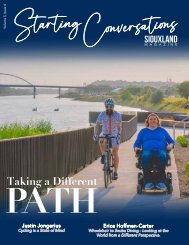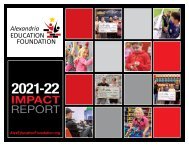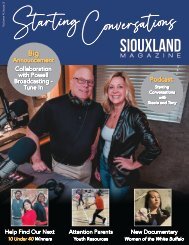Siouxland Magazine - Volume 2 Issue 2
You also want an ePaper? Increase the reach of your titles
YUMPU automatically turns print PDFs into web optimized ePapers that Google loves.
contracts and flattens in a downward motion creating<br />
pressure inside the thoracic cavity for the lungs to fill<br />
with oxygen when we take a breath in. As we exhale,<br />
the diaphragm relaxes and draws back up into its dome<br />
shape into the chest while pushing air out of the lungs.<br />
Then we have the sides of our Core Box, maybe the most<br />
critical of all core muscles, the transversus abdominis<br />
(TA). These muscle fibers wrap around our waist from<br />
the low back to the navel. When we draw the navel in to<br />
the spine, we contract this muscle, providing our trunk<br />
an all-natural back brace. So, the breath exercise to help<br />
engage these core muscles may be simple to do, but a bit<br />
more difficult to say—the transversus abdominis-assisted<br />
thoraco-diaphragmatic breath, aka TATD breath.<br />
4-point Bird-Dog: Position self on hands and knees<br />
on the floor or modify with a chair.<br />
Inhale, lift right arm and left leg. Exhale and lower. Inhale,<br />
lift left arm and right leg. Exhale and lower.<br />
In conclusion, find your core. Face the challenges you<br />
encounter with confidence and grace. Discover stability,<br />
unlock the key to the Self. The practice begins. TATD.<br />
Namaste.<br />
<strong>Siouxland</strong> <strong>Magazine</strong> | Balance /43<br />
TATD Breath: Inhale through the nose. Exhale and<br />
draw the navel in towards the spine as you contract the<br />
TA until you feel an upward lift of navel and pelvic floor<br />
muscles. Be sure not to over engage the core muscles<br />
and flatten the curvature in the low back; the goal is to<br />
maintain a neutral spine. As you inhale, feel the ribcage<br />
expand but sustain engagement throughout the TA to<br />
maintain that neutral spine.<br />
The final group of core muscles found along the<br />
backside of the core box are known as multifidus<br />
muscles and these fibers span across 2-5 vertebrae in<br />
our spine. These muscles work to create the fine stability<br />
at each segment of the spine. Weakness in these<br />
specific muscles have been found to strongly correlate<br />
with individuals with chronic low back pain. Alternate<br />
arm and leg lifts are great exercises for strengthening<br />
multifidus.<br />
Prone Swimmers: Lie face down. Inhale, lift right arm<br />
and left leg. Exhale and lower.<br />
Inhale, lift left arm and right leg. Exhale and lower.<br />
Similar to 4-point Bird-Dog photos but on belly.<br />
Dr. Meghan Nelson is a licensed physical therapist and<br />
professional yoga therapist with a passion for using yoga as<br />
medicine for optimal health, injury prevention, and overall<br />
health and wellness. Meghan is co-owner of Lumin Therapy,<br />
which provides integrative healing of the mind, body, and spirit<br />
through the practice of physical therapy, yoga and mindfulness.<br />
Like us on<br />
Facebook<br />
and<br />


















